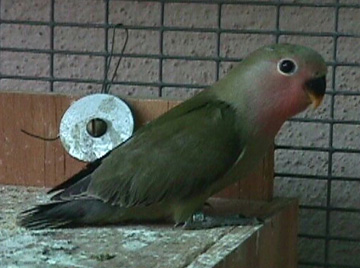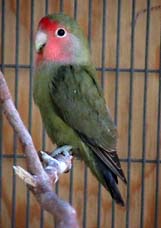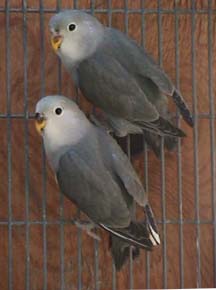If you add a second dark factor to the
green series bird, you get an Olive or Dark Green. The second dark
factor darkens the green to a more dark olive-green shade and makes
the rump grey rather than any shade of blue.
Here is a picture showing three green babies.
The first has no dark factor -- a "normal"
green.
The second has a single dark factor (as well as
a single violet factor) -- a "medium" green violet or a "jade"
violet.
And the third has two dark factors -- a "dark"
green or an "olive."

Below is a picture of a baby
olive.

Full grown, he will have a dark red face and
bib, dark olive green body, and dark grey rump. (Below is a picture
of him at 6 months - just finishing his first molt.)

In the "blue" series, a single added dark
factor gives you a "medium blue" bird, otherwise called a "cobalt" in
the U.S. This is evident mostly in the color of the rump, much like
the green birds in the photo at the top of this page.
If you add a second dark factors, you will get
a grey-green bird with a charcoal grey rump similar to the olive's
(or dark green's). But his forehead band witll be canteloupe color of
the "blue" series rather than red like the green birds. We call this
color a "slate."
Below is a photo of two young slates. But they
are whiteface slates. And the added whiteface mutation tends to give
you a bird that is closer to true grey, rather than the grey-green of
the regular slate, by reducing some of the pigment that gives the
green color.
You will also notice that the bird on the
bottom is a pied whiteface slate. This is evident in the two white
flight feathers she has in each wing.

As pieds go, this is nice, as you want your
pieds to be as symmetrical as possible, though generally a pied bird
with more pied markings would probably be more desirable in a show.
This bird is what we call very lightly pied. Click here to see more
pied
birds.
In adult plumage, the birds above will have
paper white bibs and white foreheads, which creates a stunning effect
against the charcoal grey of the body.